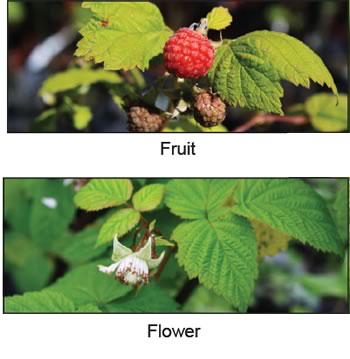Red Raspberry
Red raspberry attracts birds, butterflies, bees and other showy insects. Fruit is often used in pies or preserves or simply eaten raw.
Rubus idaeus aka Wild Red Raspberry, Red Raspberry and American Red Raspberry. Attracts birds, butterflies, bees and other showy insects. Fruit is often used in pies or preserves or simply eaten raw. Dried leaves can be made into a herb tea.
Red Raspberry Characteristics
 Leaves: Leaves are green and slightly hairy above. Lighter green beneath with whitish hairs.
Leaves: Leaves are green and slightly hairy above. Lighter green beneath with whitish hairs.
Stem/Bark: Slender prickley branches on young stems provide excellent nesting for birds. Older stems are purplish-brown, smooth and free of prickles.
Flower: Small, beautiful white flowers in June until July.
Fruit/Nut: Delicious, edible red berries maturing in late summer. Fruit is finely hairy.
Habit: Erect arching stems that trail along the ground, spreading to form thickets and colonies. Fast growing.
Hardiness: Zone 3
Height: 4’ – 6’
Width: 6’ – 8’
Why grow native plants?
A native plant is defined as a species of fauna that was already established before colonization. There are numerous benefits to the use of Native Plants. Native plants have grown and evolved in a given area for generations and therefore are more prepared to face the elements. As a result they are much hardier and less finicky to care for. The wildlife in the area has also evolved along side these plants, and because of this has formed bonds with them. Most butterflies have a specific plant species from which they collect nectar for their offspring. There are many birds that will feed directly from local trees for seed, nectar or fruit, but won’t use the bird feeder you’ve bought to attract them. These plants also work together to grow as natural plant communities. Most of the trees won’t grow their leaves until after the wildflowers have had an adequate amount of time to flower before they’re covered by shade. Finally, of course, there is the fact that all of these plants and animals combine to make a sustainable, complete, functioning ecosystem. Why fight thousands of years of evolution?
Have questions about native plants? Post a comment Ian will get back to you.






